Composition of a Citrus Tree
A commercial citrus tree usually consists of two genetically distinct parts: the scion and the rootstock. The scion is the above-ground portion of the tree and comprises the main trunk, limbs, leaves, and fruit. The rootstock, or stock, is the portion of the tree that consists of the lower trunk and the root system of the tree. Rootstocks are usually grown from seeds but can also be grown from cuttings or tissue culture. The scion is joined to the rootstock via a process called grafting, or budding, which is described in detail below. By using different cultivars for rootstock and scion, more desirable characteristics can be incorporated into one single tree. A specific cultivar for the rootstock can render a citrus tree tolerant to different stresses such as unfavorable soil conditions, soilborne pests and diseases, and cold. The rootstock can also greatly influence the size, fruit quality, and yield of a citrus tree. More information on rootstock selection can be found in the Citrus Rootstock Selection Guide (https://edis.ifas.ufl.edu/publication/hs1260). The choice of scion depends on the grower's preference and desired economic value of the cultivar.
Horticultural Terms
Plant propagation is the art and science of reproducing plants while preserving their unique characteristics from one generation to the next. Grafting is a specialized type of plant propagation where part of one plant (the scion) is inserted into another (the rootstock or stock) in such a way that they unite and grow as a single plant. Budding is a type of grafting, with the scion consisting of a single bud attached to a piece of bark and sometimes a thin sliver of wood underneath. Budding is the method of choice for propagating young citrus trees because it works well for citrus and requires less skill than other types of grafting. There are different types of budding, but those most used for citrus in Florida are the inverted T bud and the chip bud (hanging bud).
To change the cultivar of an existing citrus tree, a procedure known as top-working may be used. This involves grafting a new cultivar onto the existing scion. Several grafting procedures (including T budding) can be used to top-work citrus, but some require considerable skill.
Citrus Seeds
Seeds from many citrus varieties are polyembryonic and produce nucellar embryos, which are derived from the maternal tissue (the nucellus) that surrounds the embryo sac. This phenomenon is essential for rootstock production, as seedlings derived from nucellar embryos will be genetically identical to the mother plant. In few cases, seedlings will grow from the zygotic embryo of the seed. These plants are called "off types" and must be rogued, as they are often inferior in growth and genetically different. In some cases, the seeds will only or mainly produce zygotic embryos, in which case the rootstock will need to be propagated by other methods such as cuttings or tissue culture (see paragraph below). More information on citrus rootstock propagation can be found in the Citrus Nursery Production Guide, chapter 6 (https://edis.ifas.ufl.edu/publication/hs1329).
While seeds removed from citrus fruits will grow into trees and eventually produce fruit, fruit production usually does not occur for many years due to juvenility. Fruit produced from most citrus cultivars used as rootstocks are generally not edible and only used for the purpose of propagation.
Seeds can be purchased or extracted from mature citrus fruit. To avoid introduction of any potential disease agent, fruit should be rinsed prior to seed extraction in diluted (20%) sodium hypochlorite (bleach). In addition, seeds should be disinfected, followed by a thorough rinse with water. A short treatment in dilute potassium hydroxide or overnight incubation of the seeds with the enzyme pectinase will remove any fruit tissue adhering to the seeds after extraction. After rinsing the seeds, they should be spread out evenly on non-stick paper or aluminum foil and completely dried without direct exposure to sunlight. Seeds can be planted directly, but this is not recommended as a drying period is generally required for optimal germination. Dried seeds should be placed in polyethylene bags and stored at 40–45°F (4–10°C). For long-term storage seeds should be treated with a fungicide. Seeds should be planted at a depth of 1/4 to 1/2 inch in suitable pots or flats containing sterile potting medium. Removing the seed coats, or soaking seeds in aerated water for about eight hours just prior to planting, can reduce the time required for germination and seedling emergence. Under ideal conditions (sunlight, warm soil, and sufficient moisture), emergence will occur within 2–3 weeks after planting (Figure 1). Plants should be trained to a single stem (no branches within 6–8 inches of the soil).
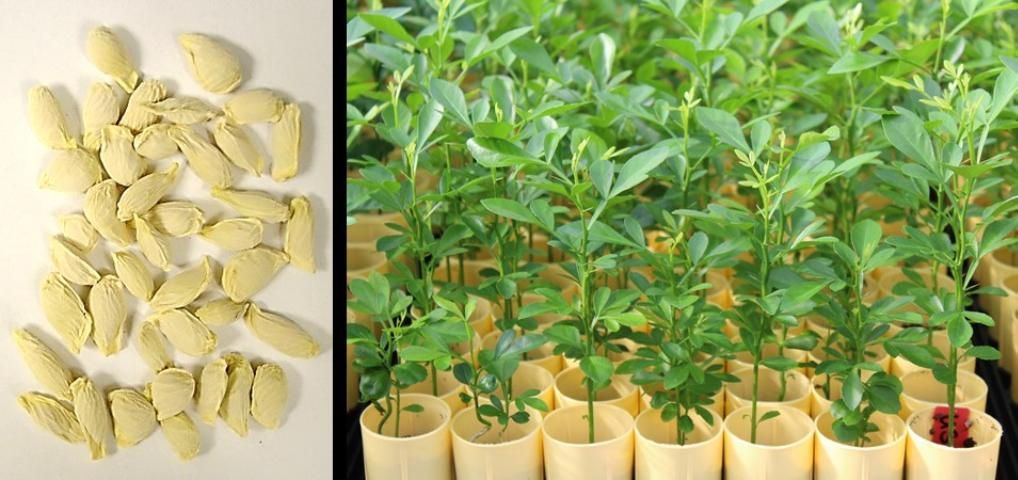
Credit: Ute Albrecht, UF/IFAS
Budding
Budwood for budding the desired scion cultivar to the rootstock must be obtained from healthy and DPI (Department of Plant Industry)-certified, disease-free budwood source trees (Figure 2). Budding is usually done when seedling stems are 1/4 to 3/8 inch in diameter (about the diameter of a pencil). Budding can be done anytime the rootstock is in a condition of active growth and the bark is slipping (the bark separates easily from the wood underneath), which is usually from April to November, depending on location. It is important to keep the stock plants (the rootstock liners) well-watered and fertilized prior to budding. The area to be budded should be pruned clean of thorns and twigs. The preferred budding height is 6–8 inches above the base of the stem.
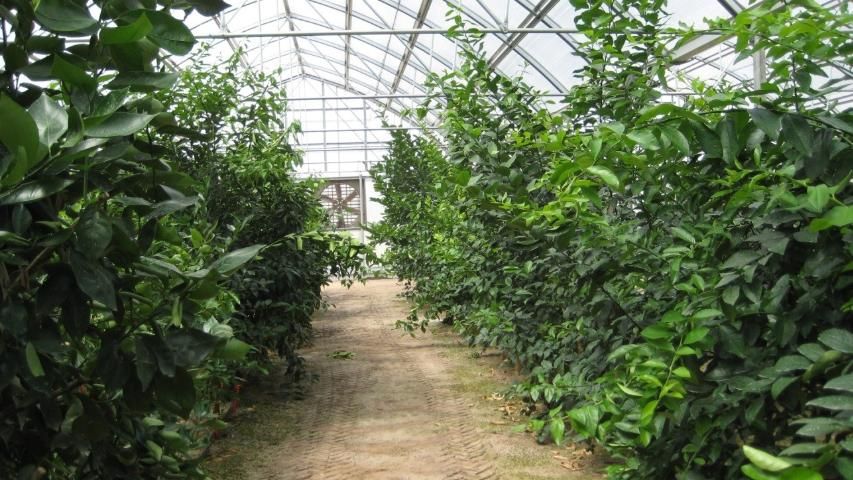
Credit: Mongi Zekri, UF/IFAS
Selection of Budwood
Budwood is usually collected from twigs from the next to last growth flush (the wood behind the current growth flush) or from the current growth flush after it has begun to harden or mature. Budwood should be round and not too angular (as is often the case for young wood), relatively straight, and should have well-formed buds in the leaf axils. Whenever possible, budwood should be approximately the same diameter as the rootstock stem to be budded.
After budwood is cut from the tree, the undesirable wood and/or growth flush should be discarded and the remaining budwood trimmed to 8 to 10-inch lengths (Figure 3). Leaves should be cut off, leaving a stub of the petiole about 1/8 inch long to protect the bud. Trimmed budsticks should be labelled as to cultivar, date, and budwood source. Although budwood can be stored in the refrigerator for 1–2 weeks after placement in polyethylene bags, it should be used as soon as possible.

Credit: Ute Albrecht, UF/IFAS
Because of the risk of introducing serious virus or virus-like diseases, the Citrus Budwood Protection Program, first established in 1957, became mandatory in 1997. Therefore, all propagations of citrus in Florida require the use of budwood from certified disease-free nursery stock in compliance with rule 5B-62, F.A.C (https://ccmedia.fdacs.gov/content/download/25182/file/Citrus-Nursery-Stock-Certification-Manual-02-14-13.pdf).
Budding Tools
The most important tool for successful budding is a razor-sharp budding knife, which can be purchased at specialty stores or at garden supply stores (Figure 4). A smooth, clean cut is necessary to allow for maximum contact between the scion and rootstock during the healing process. In addition, a sharpening stone and honing oil are needed to prevent the blade from becoming dull with use. The purchase of a diamond sharpening stone will eliminate the need for use of oil. Polyethylene budding tape (available in clear or green) is used to wrap buds to prevent drying and promote bud union formation. Using clear tape allows for observation of the bud union during the healing process.
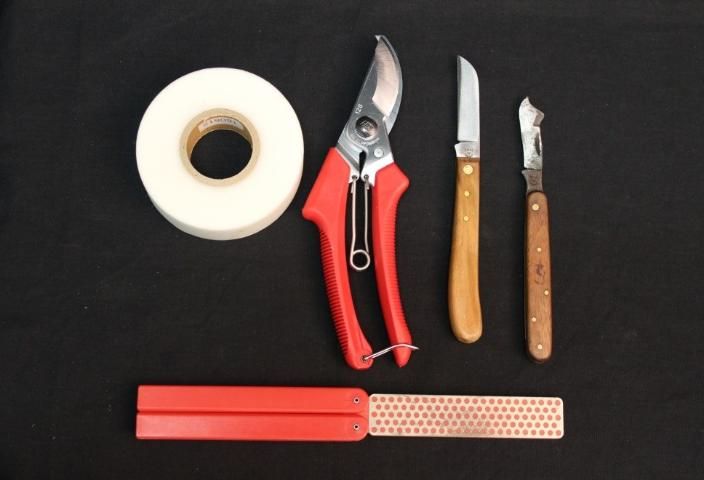
Credit: Ute Albrecht, Thang Kim, UF/IFAS
T Budding
T budding is a relatively simple procedure and is recommended over chip budding, which requires more expertise. Most Florida citrus trees are propagated by the inverted T bud procedure, but the standard (upright) T bud is also suitable. T budding can be conducted whenever the rootstock plant has attained suitable size, its bark is slipping, and budwood is available.
Before making any incision to stock or budwood, the blade of the budding knife should be disinfected to avoid transmission of any disease agent. Using the budding knife, a vertical cut of about 1.0–1.5 inch in length is made completely through the bark in a smooth area of the rootstock stem. A horizontal cut is made through the bark at the bottom (inverted T) or top (regular T) of the vertical cut (Figure 5). The cut is made at a slightly upward angle, again cutting completely through the bark. The point of the knife can be used to lift the bark along the vertical cut. A bud is removed from the budstick while holding the apical end (tip) of the budstick away from you. With the knife blade almost parallel to the axis of the budwood, a cut is made about 1/2 inch above the bud, and a shield-shaped piece of bark and wood about 3/4 to 1 inch long with a flat, smooth-cut surface is removed. Only a thin sliver of wood should remain under the bark. The bud should not be scooped out because too much wood will be removed with the bud. Avoid touching the cut surface of the bud shield by holding it between the thumb and knife blade, or by carefully using the leaf petiole stub as a handle.
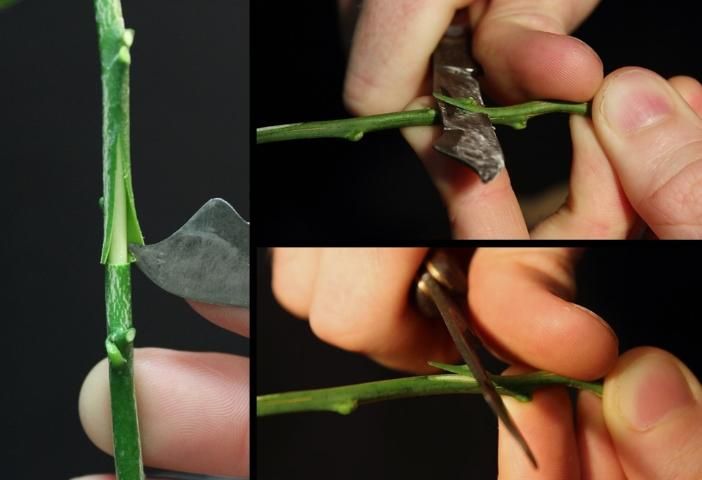
Credit: Ute Albrecht, Adam Hoeffner, UF/IFAS
The bud should be immediately inserted into the stock; the cut surface of the bud should not be allowed to dry. Slide the bud shield (the bud with associated bark and wood) under the bark flaps of the rootstock with the cut surface flat against the wood of the rootstock plant. The bud shield should be completely enclosed in the T incision (Figure 6).
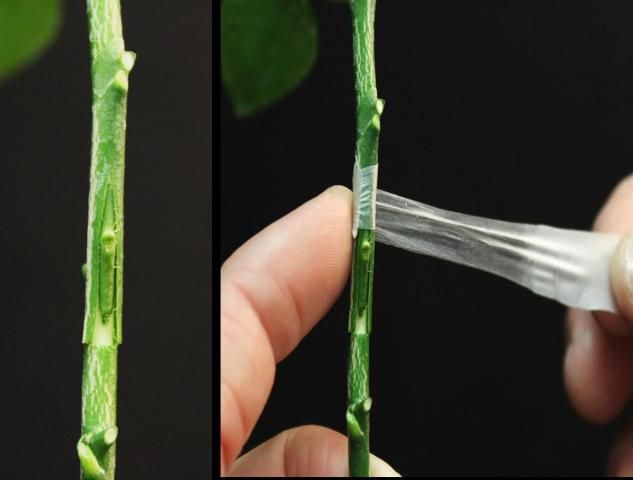
Credit: Ute Albrecht, Adam Hoeffner, UF/IFAS
Buds should be wrapped immediately following their insertion into the rootstock. Wrap buds with budding tape (polyethylene strips about 1/2 inch wide by 6–10 inches long). Begin wrapping below the bud with 3–4 turns and finish with several turns above the bud covering all exposed surfaces of the bud with tape. Alternatively, wrapping can proceed from the top down. The end of the tape is secured beneath the last circular turn. The wrap should be firm without being excessively tight. Wraps should be removed after 14–21 days and should not be left on more than 30 days. If a successful union has formed between the bud and the rootstock, the bud will be green and show no signs of shriveling or drying. Callus formation should also be evident around the edge of the bud.
Chip Budding
Chip budding requires slightly more skill than T budding and is usually done whenever the bark of the rootstock plant is not slipping or has become too thick to T bud. The chip bud is cut while holding the budstick with the apical end toward the budder. A thin slice of wood with a scion bud is removed by making a smooth upward cut about 1 inch long and just into the wood. A second cut is made at the top of the first cut, forming a notch. A chip is removed from the rootstock in a similar manner (Figure 7) and the scion bud is placed on the cut to match the cambium. Cambial tissue is a thin layer between the bark and the wood of a tree. This is an area of active cellular growth. Because only two thin lines of cambial tissue are available for healing on both the scion bud and rootstock, it is important that matching on both sides occurs whenever possible. The scion should be wrapped as described for T budding so that all cut edges are completely covered.
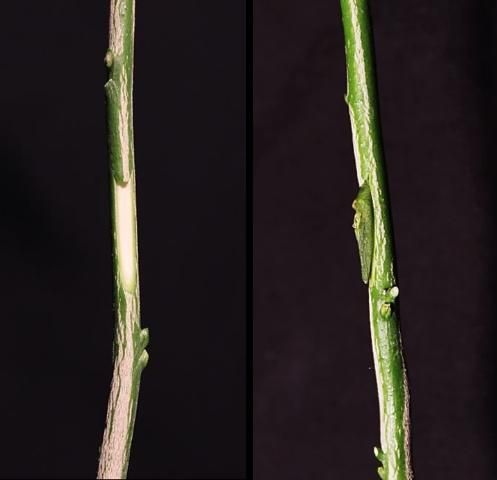
Credit: Ute Albrecht, Thang Kim, UF/IFAS
Aftercare
After the wrapping has been removed and the union between the bud and stock has occurred, the bud must be "forced" into growth. Naturally occurring plant hormones produced in the upper portion of the rootstock seedling may prevent the scion bud from growing unless the bud is forced. Buds are forced by cutting about 2/3 of the way through the stock, on the same side as the bud and about 1 to 1 1/2 inches above it. Then, the seedling top is pushed over to lie on the ground; this procedure is known as lopping. Alternatively, the seedling top is bent over to form a loop in a process called bending (Figure 8). In both cases, the rootstock top will continue to supply the roots and developing scion with food and other growth substances during the early stages of scion development (Figure 9). After the scion bud has grown several inches, the rootstock may be removed by making a cut about 1/2 inch above the scion. If lopping or bending are not practical, the rootstock top can simply be removed with a sloping cut completely through the rootstock at about 1 inch above the scion bud. Brushing a solution containing 6-benzylaminopurine (BA), a plant growth regulator, on the bud can also promote bud growth. Rootstock sprouts, which form along the main stem (especially near the scion bud), should be removed as soon as they develop because they will slow the growth of the developing scion. As the scion grows, it will need to be staked and tied at regular intervals to prevent breaking of the scion. When the nursery tree reaches a height of about 18 to 20 inches, it is ready to be planted in the field (Figure 10). The top should be pinched out to stimulate lateral shoot development.
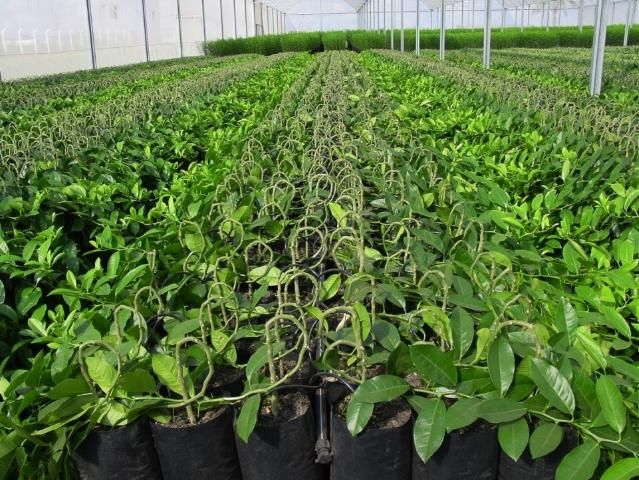
Credit: Mongi Zekri, UF/IFAS
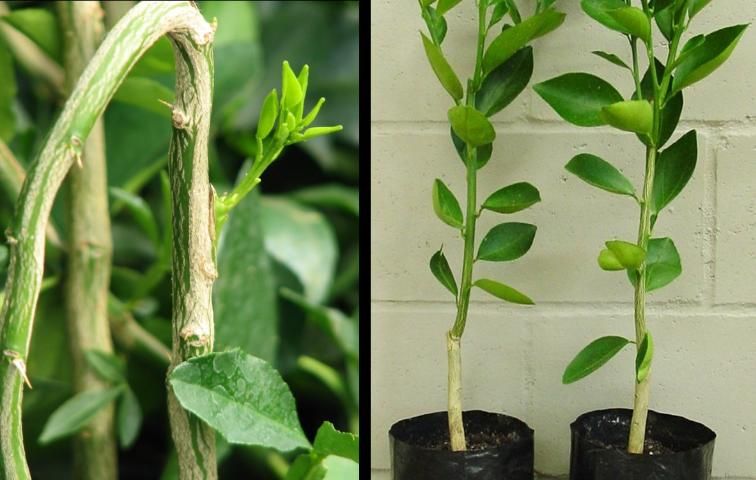
Credit: Ute Albrecht, Mongi Zekri, UF/IFAS
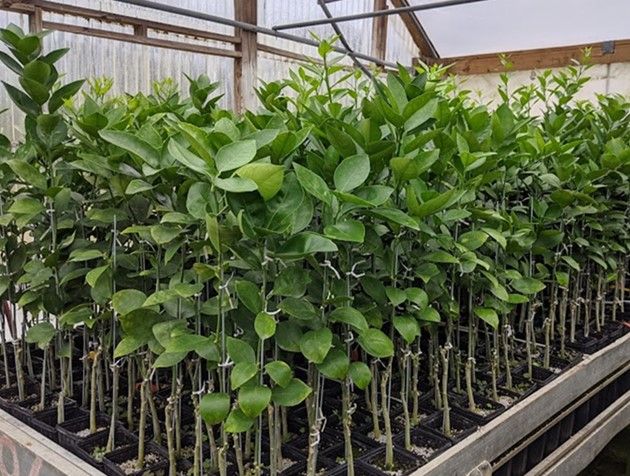
Credit: Ute Albrecht, UF/IFAS
Other Propagation Methods for Citrus
Grafting
Grafting procedures other than budding involve the use of a scion with two or more buds. There are numerous types of grafts, including whip, cleft, bridge, in-arch, stump, side, inlay bark, approach, and others. Grafting is most commonly used to repair existing trees or to top-work existing trees to change varieties.
Top-Working
Top-working is the process of changing the top of an established tree from one cultivar to another, or to multiple cultivars, by budding or grafting. Several procedures may be used when top-working citrus trees. They include bark grafting, cleft grafting, and T budding. To top-work a citrus tree by T budding, prune the tree back to leave only a few branches of 2–5-inch diameter or smaller. Insert 1–3 buds on the upper side of the remaining scaffold limbs using the T bud method. Remove unwanted buds and sprouts to ensure that only the desired scion buds grow. If limbs are so large that budding would be difficult, prune back to major scaffold limbs, removing the entire top (caution: severely pruned trees should be whitewashed to prevent sunscald). After limbs sprout back and mature a bit (6 months or so), the sprouts can be budded as initially described, using 4–6 of the stronger sprouts on each limb (Figure 11).
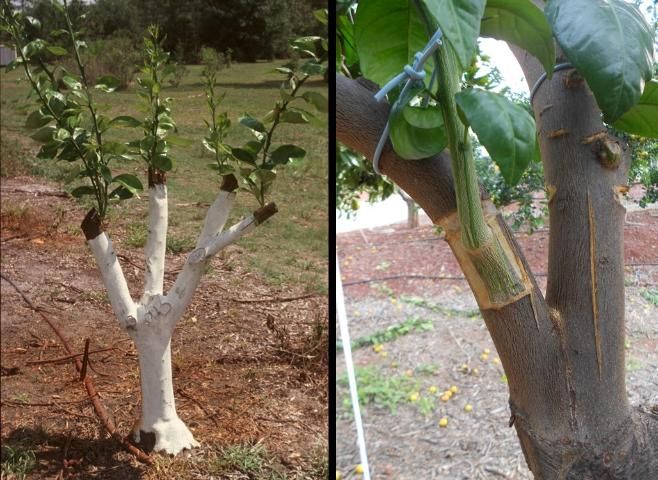
Credit: Mongi Zekri, UF/IFAS
Cuttings
Sometimes, nurseries are experiencing a shortage of seeds for some of the popular rootstock varieties, and vegetative propagation methods are required to produce large numbers of genetically identical plants. One method that is popular, especially with citrus rootstock breeders who usually do not have seed source trees available for their new selections, is the propagation of rootstocks through cuttings. For this method, single node cuttings, about 1 inch in length, are removed from woody sections of 2–5-month-old branches of certified disease-free citrus plants. The leaf remains attached to the node to allow photosynthates to be delivered to the developing roots but can be reduced to a length of 20%–30% of its original size. The basal end of each cutting is then dipped into a rooting powder containing a root-stimulating hormone, such as indole-3-acetic acid (IAA) or naphthalene acetic acid (NAA) and inserted into pre-moistened potting medium (Figure 12). Cuttings need to be kept under high-moisture conditions for the plants to survive in the absence of a root system. This can be accomplished by placing plants in an enclosed high-humidity environment and/or using an automated misting system. Under these conditions, a young plant will usually develop within several weeks after planting. Once cuttings have rooted and plants have begun to grow, care can be continued with standard procedures used for seedlings.
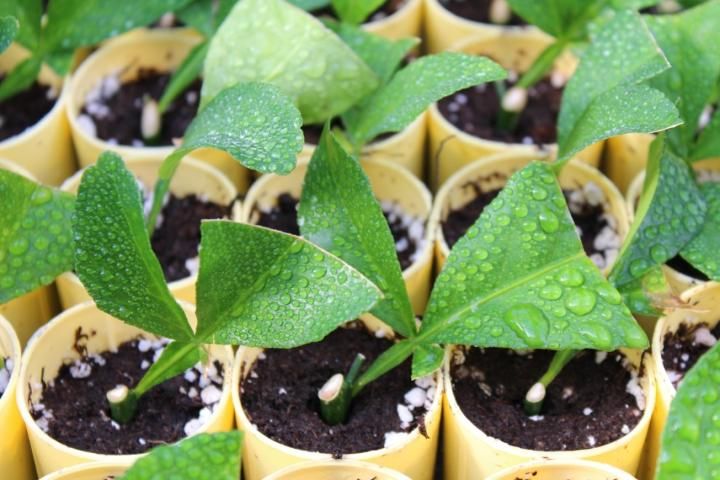
Credit: Ute Albrecht, UF/IFAS
Tissue Culture (Micropropagation)
Advances in methods for vegetative propagation of citrus rootstocks through tissue culture (micropropagation) have now made it possible to economically produce large numbers of genetically identical plants from rootstock selections. The starting material for establishing micropropagated plants varies depending on the preference of the nursery, and can consist of nucellar embryos or buds, both of which must be derived from disease-free foundation trees. The explants are placed in an agar-nutrient medium which may contain a small amount of growth regulators to accelerate plant regeneration. Once plants are regenerated, they are subcultured every few weeks on a fresh agar-nutrient medium to generate multiple shoot clusters (Figure 13). After an elongation phase, clusters are separated into individual shoots. Depending on the preference of the nursery, individual plants are then either rooted on agar medium before transplanting or directly rooted into potting medium. After an acclimatization period under high-humidity conditions, young plants can be managed using the same procedures applied for seedlings. Use of tissue culture allows the rapid propagation of large numbers of identical and disease-free plants and has become routine for many fruit crop systems.
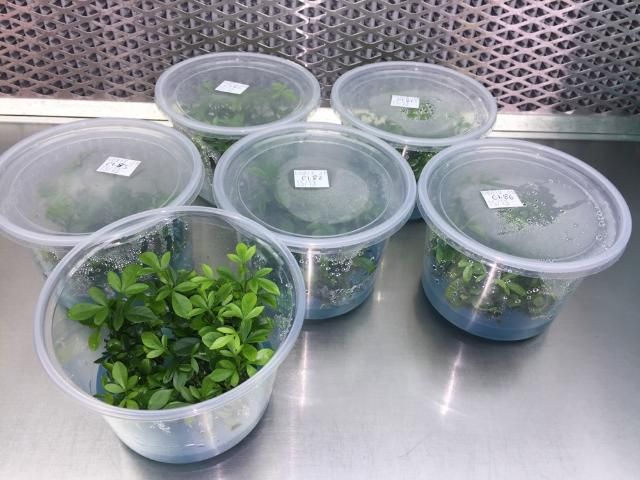
Credit: Beth Lamb, Phillip Rucks Citrus Nursery